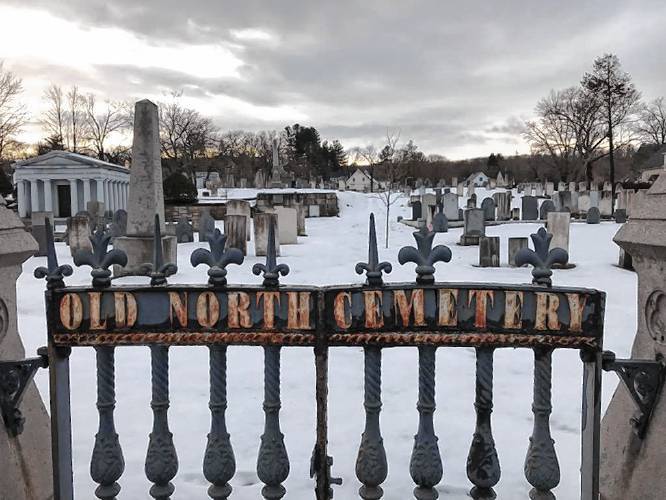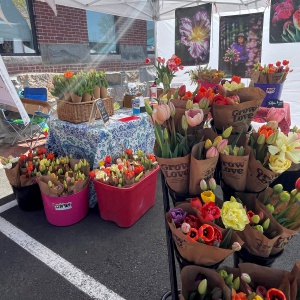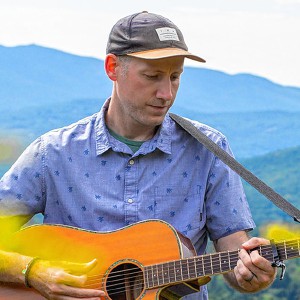Vintage Views: A grave concern

Our ancestors watched closely over the hallowed ground at the Old North Cemetery to protect their dead. Courtesy of Wendy C. Spain
| Published: 02-11-2024 12:00 PM |
There are times in life that are most sacred and respected, times such as the birth of a child, care for the elderly, nursing the very ill and ultimately the fate of death that each and every one of us will experience. Many of our sacred events are joyous and embraced by one and all, while other events will consume us, events such as the loss of a dear friend or family member. Our expectations during the grieving period are the same today as they were many years ago for our ancestors. We seek understanding, compassion and support from those surrounding us just as our ancestors did over a century ago. There is a silent understanding and we place trust in the people that guide and manage us during these days of deep sadness.
Since the very earliest days of settlement in Concord we have been fortunate to have the Old North Cemetery, a place where our ancestors could visit and pay respect for those that have passed. The act of honoring our dead is very personal, spiritual, religious and comforting. The cemetery is a place where everyone is honored the same and statesmen, presidents and the young and innocent are certainly respected equally in death. It simply does not matter what you did in life, in death we are all loved and respected.
When we conclude services and begin the period of mourning there are customs and traditions that abound. After the burial we live with challenging days, visiting frequently and mourning in our own special ways. For some it is easier than others, but we rationalize and find the road back to a better place in time. As long as there have been people there have been burial locations, places we view as hallowed and respected, places where our dead safely sleep. Sadly, this was not always the case for our ancestors.
It was during the 19th century that a very disturbing occurrence was discovered time and again. Our ancestors loved ones noticed disturbed soil over the graves of their recently departed. It was a growing concern in the early years, well published overseas in England, it slowly crept into our very own towns across the United States. The alternative of a tomb often considered but was expensive, though very convenient for families during the 1800s, a death that occurred in the depths of winter would not require the frozen ground to be excavated, the body was simply placed in the family tomb. Some tombs were quite simple, while others were very extravagant. The problem for the average citizen was the cost of building a tomb, it simply was not afforded by many of our ancestors. Early cemeteries created small vaults to hold family members that passed during the cold New Hampshire winter months with some cemeteries creating large common vaults for storage until spring burial. It soon became apparent that tombs were an easy target for graverobbers and in need of protection. Some cemeteries appointed people to roam cemeteries during the night, lantern in hand they would walk the hallowed grounds in search of robbers, while other communities could not afford this.
It was said during the early 1800’s that no cemetery in the country was safe from a person seeking to rob a grave. This criminal act was common for two reasons in particular, the graves were robbed by people searching for items of value that were buried with the recently departed, a gold wedding band or favorite pocket watch perhaps. The second reason a grave was robbed related to medical schools of the time. The medical colleges of centuries past were in desperate need of every corpse they could purchase so that they could use them to educate the students attending medical school. During the early to mid-1800s a medical student could actually pay their full college tuition by providing a body or two to the school. During this period no questions were asked and the need was very well known.
There is a cemetery in Plymouth, New Hampshire that actually published an unusual story during the 1800s. A recently deceased family member was buried in the traditional manner, a series of wires were attached to the body with the buried wire leading to a nearby residence and attached to bells. If a robber showed up during the evening and attempted to remove the body from the grave under the cover of darkness the bells would chime and alert the caretaker to the theft.
In the year 1831 there was a death in Hopkinton, New Hampshire. Joseph Philbrick passed away and was buried in the cemetery located in Contoocook Village. Overcome with the sadness of her husband’s death his widow followed him to the grave within a few short days. Knowing that she would die soon she requested that her coffin should be placed into the hallowed ground beside her recently deceased husband, she said she wished for her coffin to be placed closely to her husbands, actually touching her husband’s coffin side by side. The cemetery sextant honored her wish and had dug the grave in a manner that would allow the two coffins to touch for eternity. As the gravedigger dug closely to the recently deceased Joseph Philbrick, he noticed a very unusual situation, there was buried pieces of debris uncovered. As he dug some more, he discovered more buried rubbish that was not there the week before when he buried Mr. Philbrick. The local constables were contacted and joined the sextant as he investigated further. As each shovel of soil was removed it was with growing concern that they discovered Mr. Philbrick’s body was missing.
A very intense and certainly emotional investigation was conducted without finding a clue. It was apparent the body was taken just days prior to the death of Mrs. Philbrick. Search parties were organized and there was much discussion about town, where was Mr. Philbrick? With the focus of such attention, it was apparent that the graverobbers would have a difficult time selling the body. In the following days Mr. Joseph Philbrick’s body was found a distance away in a wooded swamp.
Article continues after...
Yesterday's Most Read Articles
Mr. Philbrick was returned to the cemetery where he does rest with his beloved wife until this very day. Buried closely side by side, one coffin gently touching the other, the husband and wife separated briefly in death rest eternally together in peace.


 Northeast Coffee Festival comes to Concord this weekend
Northeast Coffee Festival comes to Concord this weekend Henniker Handmade & Homegrown
Henniker Handmade & Homegrown Colonial Theatre Laconia presents Piff the Magic Dragon
Colonial Theatre Laconia presents Piff the Magic Dragon The Loft at Hermit Woods presents Pete Kilpatrick
The Loft at Hermit Woods presents Pete Kilpatrick 
